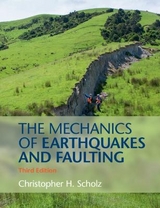
The Mechanics of Earthquakes and Faulting
Seiten
2002
|
2nd Revised edition
Cambridge University Press (Verlag)
9780521655408 (ISBN)
Cambridge University Press (Verlag)
9780521655408 (ISBN)
- Titel erscheint in neuer Auflage
- Artikel merken
Zu diesem Artikel existiert eine Nachauflage
This revised second edition, first published in 2002, was thoroughly up-dated to include all of the previous decade's major advances in the understanding of earthquakes and faulting processes. Essential reading for graduate students and research scientists in the fields of seismology, physics, geology, geodesy and rock mechanics.
Our understanding of earthquakes and faulting processes has developed significantly since publication of the successful first edition of this book in 1990. This revised edition, first published in 2002, was therefore thoroughly up-dated whilst maintaining and developing the two major themes of the first edition. The first of these themes is the connection between fault and earthquake mechanics, including fault scaling laws, the nature of fault populations, and how these result from the processes of fault growth and interaction. The second major theme is the central role of the rate-state friction laws in earthquake mechanics, which provide a unifying framework within which a wide range of faulting phenomena can be interpreted. With the inclusion of two chapters explaining brittle fracture and rock friction from first principles, this book is written at a level which will appeal to graduate students and research scientists in the fields of seismology, physics, geology, geodesy and rock mechanics.
Our understanding of earthquakes and faulting processes has developed significantly since publication of the successful first edition of this book in 1990. This revised edition, first published in 2002, was therefore thoroughly up-dated whilst maintaining and developing the two major themes of the first edition. The first of these themes is the connection between fault and earthquake mechanics, including fault scaling laws, the nature of fault populations, and how these result from the processes of fault growth and interaction. The second major theme is the central role of the rate-state friction laws in earthquake mechanics, which provide a unifying framework within which a wide range of faulting phenomena can be interpreted. With the inclusion of two chapters explaining brittle fracture and rock friction from first principles, this book is written at a level which will appeal to graduate students and research scientists in the fields of seismology, physics, geology, geodesy and rock mechanics.
Preface; 1. Brittle fracture of rock; 2. Rock friction; 3. Mechanics of faulting; 4. Mechanics of earthquakes; 5. The seismic cycle; 6. Seismotectonics; 7. Earthquake prediction and hazard analysis; References; Index.
| Erscheint lt. Verlag | 2.5.2002 |
|---|---|
| Zusatzinfo | 1 Tables, unspecified; 9 Plates, color; 219 Line drawings, unspecified |
| Verlagsort | Cambridge |
| Sprache | englisch |
| Maße | 176 x 247 mm |
| Gewicht | 1100 g |
| Themenwelt | Naturwissenschaften ► Geowissenschaften ► Allgemeines / Lexika |
| Naturwissenschaften ► Geowissenschaften ► Geologie | |
| Naturwissenschaften ► Geowissenschaften ► Geophysik | |
| ISBN-13 | 9780521655408 / 9780521655408 |
| Zustand | Neuware |
| Informationen gemäß Produktsicherheitsverordnung (GPSR) | |
| Haben Sie eine Frage zum Produkt? |
Mehr entdecken
aus dem Bereich
aus dem Bereich



